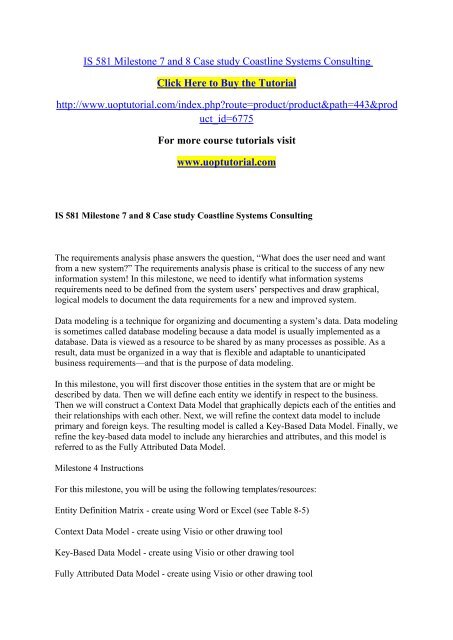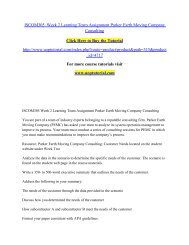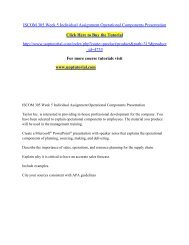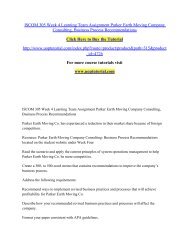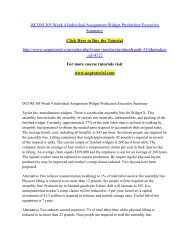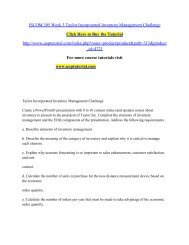IS 581 Milestone 7 and 8 Case study Coastline Systems Consulting
IS 581 Milestone 7 and 8 Case study Coastline Systems Consulting The requirements analysis phase answers the question, “What does the user need and want from a new system?” The requirements analysis phase is critical to the success of any new information system! In this milestone, we need to identify what information systems requirements need to be defined from the system users’ perspectives and draw graphical, logical models to document the data requirements for a new and improved system. Data modeling is a technique for organizing and documenting a system’s data. Data modeling is sometimes called database modeling because a data model is usually implemented as a database. Data is viewed as a resource to be shared by as many processes as possible. As a result, data must be organized in a way that is flexible and adaptable to unanticipated business requirements—and that is the purpose of data modeling. In this milestone, you will first discover those entities in the system that are or might be described by data. Then we will define each entity we identify in respect to the business. Then we will construct a Context Data Model that graphically depicts each of the entities and their relationships with each other. Next, we will refine the context data model to include primary and foreign keys. The resulting model is called a Key-Based Data Model. Finally, we refine the key-based data model to include any hierarchies and attributes, and this model is referred to as the Fully Attributed Data Model. Milestone 4 Instructions For this milestone, you will be using the following templates/resources: Entity Definition Matrix - create using Word or Excel (see Table 8-5) Context Data Model - create using Visio or other drawing tool Key-Based Data Model - create using Visio or other drawing tool Fully Attributed Data Model - create using Visio or other drawing tool
IS 581 Milestone 7 and 8 Case study Coastline Systems Consulting
The requirements analysis phase answers the question, “What does the user need and want from a new system?” The requirements analysis phase is critical to the success of any new information system! In this milestone, we need to identify what information systems requirements need to be defined from the system users’ perspectives and draw graphical, logical models to document the data requirements for a new and improved system.
Data modeling is a technique for organizing and documenting a system’s data. Data modeling is sometimes called database modeling because a data model is usually implemented as a database. Data is viewed as a resource to be shared by as many processes as possible. As a result, data must be organized in a way that is flexible and adaptable to unanticipated business requirements—and that is the purpose of data modeling.
In this milestone, you will first discover those entities in the system that are or might be described by data. Then we will define each entity we identify in respect to the business. Then we will construct a Context Data Model that graphically depicts each of the entities and their relationships with each other. Next, we will refine the context data model to include primary and foreign keys. The resulting model is called a Key-Based Data Model. Finally, we refine the key-based data model to include any hierarchies and attributes, and this model is referred to as the Fully Attributed Data Model.
Milestone 4 Instructions
For this milestone, you will be using the following templates/resources:
Entity Definition Matrix - create using Word or Excel (see Table 8-5)
Context Data Model - create using Visio or other drawing tool
Key-Based Data Model - create using Visio or other drawing tool
Fully Attributed Data Model - create using Visio or other drawing tool
- No tags were found...
Create successful ePaper yourself
Turn your PDF publications into a flip-book with our unique Google optimized e-Paper software.
<strong>IS</strong> <strong>581</strong> <strong>Milestone</strong> 7 <strong>and</strong> 8 <strong>Case</strong> <strong>study</strong> <strong>Coastline</strong> <strong>Systems</strong> <strong>Consulting</strong><br />
Click Here to Buy the Tutorial<br />
http://www.uoptutorial.com/index.php?route=product/product&path=443&prod<br />
uct_id=6775<br />
For more course tutorials visit<br />
www.uoptutorial.com<br />
<strong>IS</strong> <strong>581</strong> <strong>Milestone</strong> 7 <strong>and</strong> 8 <strong>Case</strong> <strong>study</strong> <strong>Coastline</strong> <strong>Systems</strong> <strong>Consulting</strong><br />
The requirements analysis phase answers the question, “What does the user need <strong>and</strong> want<br />
from a new system?” The requirements analysis phase is critical to the success of any new<br />
information system! In this milestone, we need to identify what information systems<br />
requirements need to be defined from the system users’ perspectives <strong>and</strong> draw graphical,<br />
logical models to document the data requirements for a new <strong>and</strong> improved system.<br />
Data modeling is a technique for organizing <strong>and</strong> documenting a system’s data. Data modeling<br />
is sometimes called database modeling because a data model is usually implemented as a<br />
database. Data is viewed as a resource to be shared by as many processes as possible. As a<br />
result, data must be organized in a way that is flexible <strong>and</strong> adaptable to unanticipated<br />
business requirements—<strong>and</strong> that is the purpose of data modeling.<br />
In this milestone, you will first discover those entities in the system that are or might be<br />
described by data. Then we will define each entity we identify in respect to the business.<br />
Then we will construct a Context Data Model that graphically depicts each of the entities <strong>and</strong><br />
their relationships with each other. Next, we will refine the context data model to include<br />
primary <strong>and</strong> foreign keys. The resulting model is called a Key-Based Data Model. Finally, we<br />
refine the key-based data model to include any hierarchies <strong>and</strong> attributes, <strong>and</strong> this model is<br />
referred to as the Fully Attributed Data Model.<br />
<strong>Milestone</strong> 4 Instructions<br />
For this milestone, you will be using the following templates/resources:<br />
Entity Definition Matrix - create using Word or Excel (see Table 8-5)<br />
Context Data Model - create using Visio or other drawing tool<br />
Key-Based Data Model - create using Visio or other drawing tool<br />
Fully Attributed Data Model - create using Visio or other drawing tool


